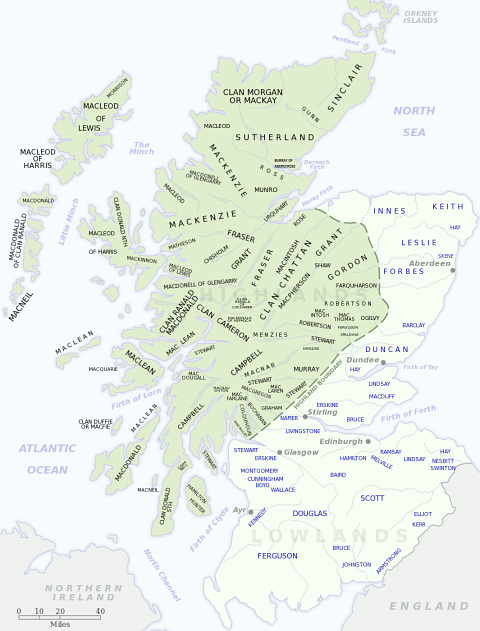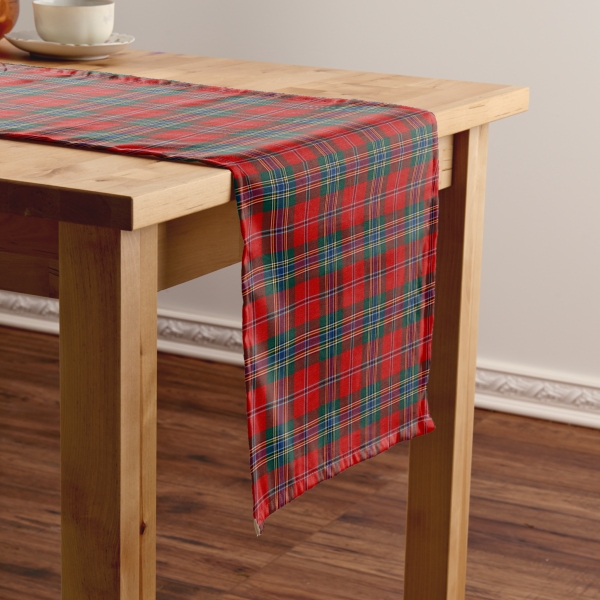
Motto: Virtue Mine Honour
Historic Seat: Duart Castle
District: Mull
Associated Surnames: Beath, Black, Clanachan, Garvie, Gillon, Lean, MacBeath, MacBeth, MacBheath, MacCormick, MacCraken, MacIlduy, MacLergain, MacRankin, MacVeagh, MacVeagh, MacVey, Patton
Associated Tartans:
Early MacLean Genealogy and History:
(Excerpt from "The Scottish Clans and Their Tartans", James Grant, 1906)
The ancient Sennachies have asserted that the surname of MacLean was originally MacGillian, derived from a famous Celtic warrior who was known as Gillian-nan-Tuagh, or of the battle axe, which his descendants use as their crest to this day between a laurel and cypress branch.
This powerful and numerous clan has been seated in the Island of Mull from a very remote period, but did not appear, like several others, as an independent one till the forfeiture of the Lord of the Isles in 1476; though, of course, as vassals of these princes they existed long under chiefs of their own. Their genealogy deduces them from Gilleain, the son of Jerath.
The Castle of Duart, so called, occupies the verge of a high cliff on the coast of Mull. It is of great antiquity, and is a square tower with walls of enormous thickness. Two buildings of more recent date, one of which was occupied as a garrison in the last century, connected by a high wall with the keep, form an oblong square of 120 by 72 feet.
Among the list of the slain at Flodden,1 Dr Abercrombie ("Martial Achievements, etc.") gives the name of Hector MacLean of Duart.
Lachlan Cattanach MacLean of Duart married Lady Elizabeth, a daughter of Archibald, Earl of Argyll, who fell at Flodden leading the vanguard; and she was the heroine of that story connected with "The Lady's Rock," which lies between Lismore and the coast of Mull. Lachlan resolved to get rid of his wife; he caused her to be exposed on the rock, which was only visible at low water, intending that she should be swept away by the return of the tide. From this situation the intended victim was rescued by a boat passing, and conveyed to her brother's house. Her relations smothered their resentment for a time, but only to break out afterwards with greater violence; for Duart, being in Edinburgh, was surprised when in bed, and assassinated by Sir John Campbell of Calder, the lady's brother.
In 1536 Hector MacLean, then of Duart, with Keppoch and others, signed a bond of Manrent2 "vitht my hand at the pen," to George, Earl of Huntly , at the castle of that name (Spald. Club Miscell. iv.).
In 1579 Hector MacLean of Coll complained to the Council that he had been "utterlie wrakkit"3 by Lachlan MacLean of Duart, who had captured his castle and destroyed its plenishing;4 for which Lachlan was summoned to appear within six days, or be put to the horn. He prosecuted a feud with MacDonald of Dunyvag; he was accused of causing to "strek the heid from Hector MacLean Allanson;" of imprisoning Donald MacLean in Carnbulg; and of having nine "maist honest men" and two women murdered at his instance in the Isle of Gigha.
Lachlan of Duart was afterwards knighted, and proved himself a gallant soldier at the battle of Glenlivat5 in 1594. In 1598 he fought in the dreadful clan battle of Lochgruinard6 against the MacDonalds of Islay, which he wished to conquer, when he was slain, "courageously fighting with 80 of the principal men of his kin, and 200 common soldiers lying dead about him. His son, Lachlan Barroch MacLean, was chased with the rest of his men even to their boats and vessels." The battle of Benbigger followed, in which the MacDonalds were almost cut off by the MacLeans and three other clans, acting under the orders of James VI.
In 1632 Lachlan MacLean of Duart was created a baronet of Nova Scotia by Charles I, to whom he was zealously attached, and in whose cause he participated in all the triumphs of Montrose. He died in 1649, and was succeeded by his son Hector, who fell at the battle of Inverkiething7 in 1651. The title devolved upon his brother, Alan, who died in 1674, and was succeeded by his only son, Sir John, who raised the clan at the Revolution, and joining Viscount Dundee, fought at the victorious battle of Killiecrankie.8 In 1715 he unfurled the standard of loyalty again, and joining the Earl of Mar, fought at Sheriffmuir.9 By his wife Mary, daughter of Angus MacPherson of Essick, he left a son, Sir Hector, who was apprehended in Edinburgh in 1745 on suspicion of being in the French service and enlisting men for it. He was conveyed to London, and kept there a prisoner for two years, till the Act of Grace was passed. In 1745 the clan could muster 500 claymores. They were in the first line at Culloden10 under the Duke of Perth.
Sir Hector died unmarried at Paris in 1750, when the title devolved upon his cousin (great grandson of Donald MacLean of Broloss) from whom the present baronet is lineally descended. One of this clan, Colonel Lachlan MacLean, was much involved in the political affairs of Warren Hastings in 1776. Two of the clan attained military rank in the service of Portugal. Colonel MacLean, who had served in the army of that country from 1763, was in 1773, appointed General-in-Chief and Governor of Lisbon. He had previously been Governor of Almeida and the whole province of Beira. In the same year Lieutenant-General MacLean succeeded Don José A. Francis Lobo, County of Oriolo, as Governor of Portuguese Estremadura, the first military honour in the kingdom ever given to any but the highest of nobles.
(End excerpt)
Next page: Clan MacLennan
Footnotes:
1 The Battle of Flodden (1513): The Battle of Flodden Field was fought on 9 September 1513, in Northumberland England between an army of Scots under King James IV and an English army commanded by the Earl of Surrey. Read more about the Battle of Flodden at Wikipedia.
2 Manrent: A Scottish contract of the mid-15th century to the early 17th century, usually military in nature and involving Scottish clans. The bond of manrent was commonly an instrument in which a weaker man or clan pledged to serve, in return for protection, a stronger lord or clan. Essentially, it was a promise by one person to serve another, such that he shall be friend to all his friends, and foe to all his foes. Read more about Manrents at Wikipedia.
3 utterlie wrakkit: completely harmed, hurt, damaged or destroyed
4 plenishing: livestock, furnishings, and supplies
5 The Battle of Glenlivet (1603): The battle of Glenlivet was fought on 3 October 1594, at Allanreid in the historic county of Banffshire near Moray, Scotland, and is often seen as a religious conflict. It was fought between the Catholic forces of George Gordon, 1st Marquess of Huntly and Francis Hay, 9th Earl of Erroll, who were victorious over the Protestant forces of Archibald Campbell, 7th Earl of Argyll. Read more about the Battle of Glenlivet at Wikipedia.
6 The Battle of Guinard Strand (1598): The Battle of Traigh Ghruinneart, also known as the Battle of Guinard Strand, and referenced as Lochguinard in the above-mentioned book, was fought on 5 August 1598, on the Isle of Islay over ownership of the island, between the clans MacDonald and MacLean. Read more about the Battle of Guinard Strand at Wikipedia.
7 The Battle of Inverkeithing (1651): The Battle of Inverkeithing was fought on 20 July 1651 in Inverkeithing, a port town and parish in Fife, Scotland. It was fought between an English Parliamentarian army led by John Lambert, and a Scottish Covenanter army led by Sir John Brown of Fordell on behalf of Charles II. Read more about the Battle of Inverkeithing at Wikipedia.
8 The Battle of Killiecrankie (1689): The Battle of Killiecrankie was fought on 27 July 1689 near Killiecrankie, in Perthshire, Scotland. It took place during the First Jacobite Rising between a Jacobite force of Scots and Irish, and those of the newly arrived William of Orange's Scottish government forces. Read more about the Battle of Killiecrankie at Wikipedia.
9 The Battle of Sheriffmuir (1715): The Battle of Sheriffmuir was fought on 13 November 1715, led by John Erskine, 6th Earl of Mar, standard-bearer for the Jacobite cause in Scotland, and British Government forces, led by John Campbell, 2nd Duke of Argyll. It took place on the slopes of the Ochil Hills in Scotland, just inside the Perthshire border. Read more about the Battle of Sheriffmuir at Wikipedia.
10 The Battle of Culloden (1746): The Battle of Culloden was fought on 16 April 1746, on Drummossie Moor, near Culloden, east of Inverness Scotland, between Scottish forces led by Charles Edward Stuart (Bonnie Prince Charlie) and English forces led by William Augustus, Duke of Cumberland. It was the final confrontation of the Jacobite rising of 1745. Read more about the Battle of Culloden at Wikipedia.

Distribution of Scottish clans and families
View larger map at Wikimedia Commons

Browse the Clan MacLean Tartan Collection with home decor, personal accessories, crafting, paper products, and more.

Browse the Clan MacLean Hunting Tartan Collection with home decor, personal accessories, crafting, paper products, and more.

Clan MacLean Postcard: Digitally cleaned and enhanced vintage illustration with tartan frame.